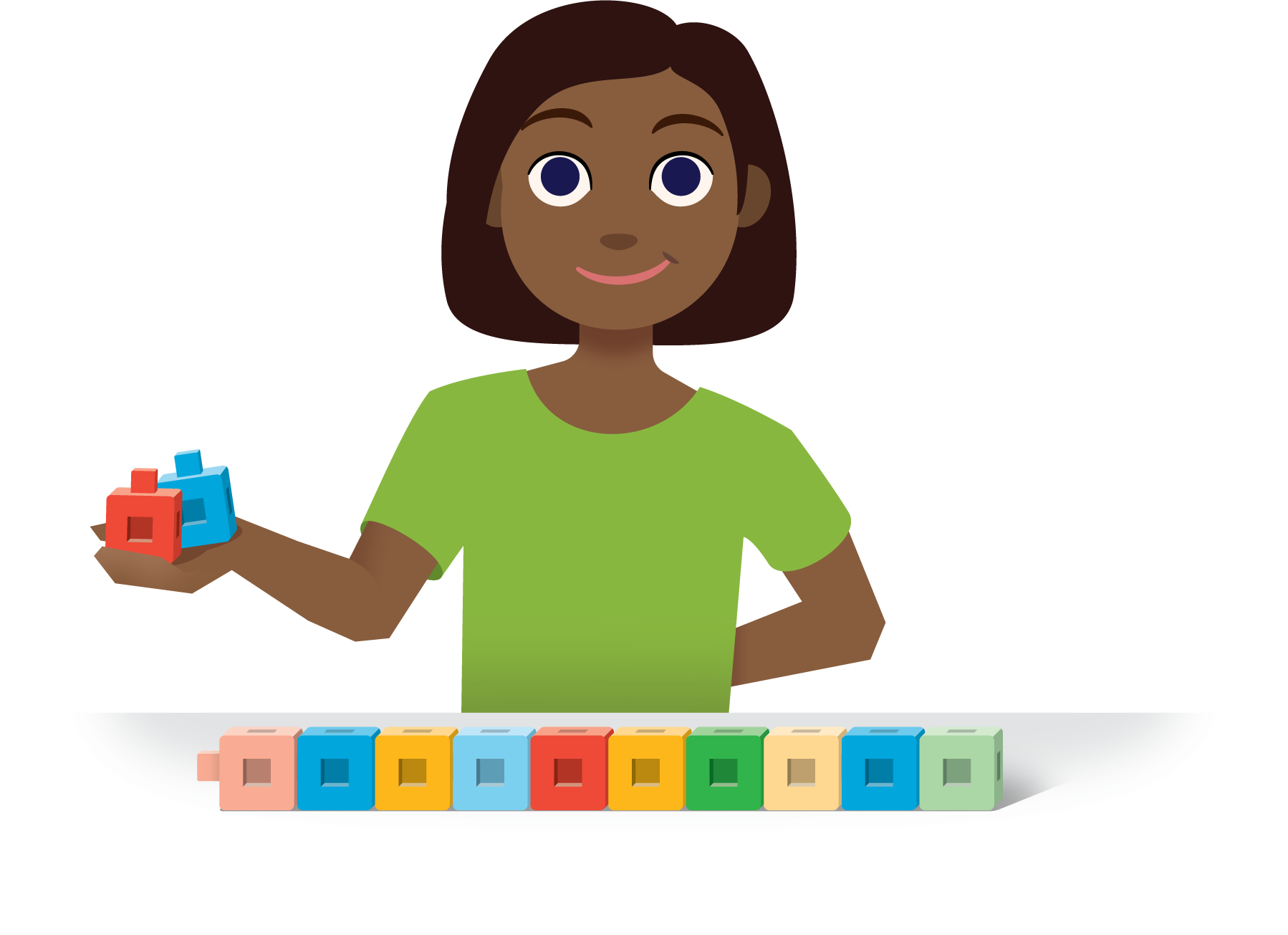Lesson 3
A Change is Coming
Warm-up: Notice and Wonder: Kiran’s Books (10 minutes)
Narrative
Launch
- Groups of 2
- Display story problem.
- “What do you notice? What do you wonder?”
- 1 minute: quiet think time
Activity
- “Discuss your thinking with your partner.”
- 1 minute: partner discussion
- Share and record responses.
Student Facing
What do you notice?
What do you wonder?
Kiran has some books.
His friend gives him some more books.

Student Response
For access, consult one of our IM Certified Partners.
Activity Synthesis
- “Where might numbers fit into this story problem?” (To tell the number of books Kiran has and the number of books he gets from his friend. To tell how many books Kiran has in all.)
Activity 1: Kiran’s Books (15 minutes)
Narrative
The purpose of this activity is for students to solve a new type of story problem, Add To, Change Unknown. Students may solve in any way that makes sense to them. Monitor for students who show six connecting cubes or two-color counters and add two more to make eight. Students may also draw pictures, and use words or numbers, including mental math and expressions, to represent the problem. Some students may show eight, then remove the six. This is an appropriate method for solving, but the emphasis for this lesson is on addition. Students may write an equation that matches the story problem but not be able to determine which number in the equation tells the answer. Students will practice completing equations in the next activity.
The teacher selects and sequences student work as suggested in the activity. In the activity synthesis, this work is displayed and students look at how the answer to the question is shown in different representations, including the equation. When students connect different representations and explain the connections, they model with mathematics (MP4).
Advances: Representing, Conversing
Required Materials
Materials to Gather
Launch
- Groups of 2
- Give students access to 10-frames and connecting cubes or two-color counters.
- Display and read the problem.
- “This is the problem from our warm-up. What new information did you learn? What do you still wonder?” (I learned how many books Kiran had in the beginning and how many he has at the end. I still wonder how many his friend gave him.)
- 1 minute: quiet think time
- Share and record answers.
Activity
- "Now solve the problem in a way that makes sense to you."
- 2 minutes: independent work time
- “Share your thinking with your partner.”
- 2 minutes: partner discussion
- Monitor and select students with the following methods to share in the synthesis:
- show six objects, add two more, counting up to 8
- draw six marks, draw two more, counting up to 8
- start at 6 and count up mentally
- write an addition expression
Student Facing
Kiran has 6 books.
His friend gives him some more books.
Now he has 8 books.
How many books did Kiran get from his friend?
Show your thinking using drawings, numbers, or words.
Student Response
For access, consult one of our IM Certified Partners.
Advancing Student Thinking
- "Can you explain how you solved the problem?"
- "How could you use connecting cubes to show that Kiran started with six books and ended up with eight books?"
Activity Synthesis
- Invite previously identified students to share in the given order.
- “Where do you see the answer to the question in each method?”
- If needed, display \(6 + 2 = 8\).
- “How does this equation match this method?” (\(6 + 2\) shows the number of books Kiran has plus the number he gets from his friend. 8 is the total number of books he has.)
- "Where should we put the box in this equation? Why should we put it there?" (Put a box around the 2 because it is the answer to the problem.)
Activity 2: Lin Represents a Story Problem (10 minutes)
Narrative
The purpose of this activity is for students to make sense of an Add To, Change Unknown story problem and identify the answer within an equation. Students are presented with a drawn representation and an equation to interpret. Students consider what each number in the equation means in relation to the story problem and drawn representation (MP2). They determine that the written equation is incorrect, and explain why using their own thinking. When students practice explaining their thinking, they begin to develop and refine their mathematical communication skills, and attend to precision (MP6). Students identify that even though Mai's equation has the correct numbers she identified the wrong number as the solution to the problem (MP3).
Students keep their books closed for the launch of the activity, as the teacher displays and reads the problem.
Supports accessibility for: Attention, Organization
Required Materials
Materials to Gather
Launch
- Groups of 2
- Give students access to 10-frames and connecting cubes or two-color counters.
- "I am going to read another story problem. Think about what you notice and wonder about the problem as I read aloud."
- Display and read the problem with missing information.
- 30 seconds: quiet think time
- Share and record answers.
Activity
- "Now we will get more information and see how Lin solved the problem."
- Read the problem aloud.
- "Look at Lin's drawing and her equation. Think about how she solved the problem."
- 1 minute: quiet think time
- “Share your thinking with your partner. Then show whether or not you think Lin's equation is correct.”
- 4 minutes: partner work time
Student Facing
-
Andre checked out some books from the library.
Mai gives him more books.
Now he has 9 books.What do you notice?
What do you wonder? -
Andre checked out 3 books from the library.
Mai gives him some more books.
Now he has 9 books.
How many books did Mai give him?Lin made this drawing.

She wrote the equation\(3 + 6 = \boxed{9}\)
Is her equation correct?
Show your thinking using drawings, number, or words.
Student Response
For access, consult one of our IM Certified Partners.
Activity Synthesis
- “How does Lin’s drawing show the story problem?” (She shows the three books Andre starts with, and the six books she needs to get to nine.)
- "Does Lin's equation match the story? Why or why not?" (No. The answer to the problem is how many books Mai gives Andre. That answer is 6, so the equation should be \(3 + \boxed{6} = 9\) .)
- If needed ask, “How does this equation match the story problem?” (Andre has three books. Mai gives him six, which is the answer, so that he has nine total.)
Activity 3: Centers: Choice Time (15 minutes)
Narrative
The purpose of this activity is for students to choose from activities that offer practice adding and subtracting within 10 or organizing and representing data. Students choose from any stage of previously introduced centers.
- Sort and Display
- Check it Off
- What’s Behind My Back
Required Materials
Materials to Gather
Required Preparation
- Gather materials from previous centers:
- Sort and Display, Stage 1
- Check it Off, Stages 1 and 2
- What's Behind My Back, Stage 2
Launch
- Groups of 2
- “Now you are going to choose from centers we have already learned.”
- Display the center choices in the student book.
- “Think about what you would like to do.”
- 30 seconds: quiet think time
Activity
- Invite students to work at the center of their choice.
- 10 minutes: center work time
Student Facing
Choose a center.
Sort and Display

Check it Off

What’s Behind My Back

Activity Synthesis
- “Jada likes to play What’s Behind My Back. She uses her fingers to figure out how many cubes are behind her partner’s back. How do you think she uses her fingers?” (She can count the cubes that her partner shows her and hold up that many fingers. Then she can see how many fingers are down and that is how many are behind her partner’s back.)
- “Why do you think Jada likes to use her fingers instead of cubes?” (With cubes you have to count out 10 first. We already know we have 10 fingers.)
Lesson Synthesis
Lesson Synthesis
Display \(3 + 6 = \boxed{9}\) and \(3 + \boxed{6} = 9\).
“Today we discussed how equations with the same numbers can mean different things. How are these equations the same? How are they different?” (Both equations show \(3 + 6\) is the same amount as 9. They represent different story problems. The answer is different in each equation. How I solve each equation is different.)
Cool-down: Unit 2, Section A Checkpoint (0 minutes)
Cool-Down
For access, consult one of our IM Certified Partners.